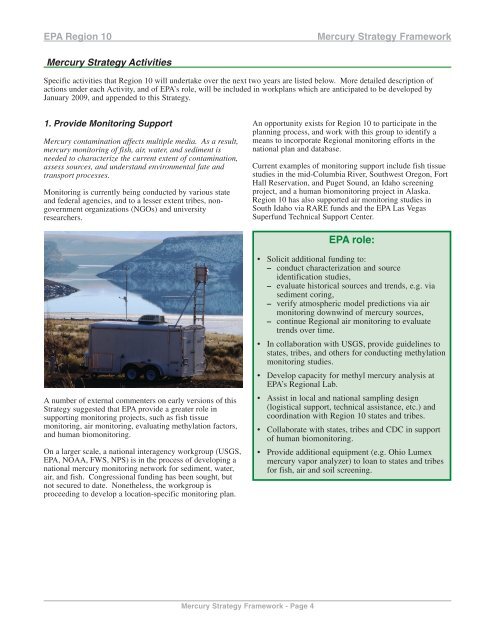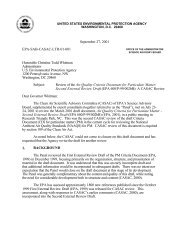EPA Region 10 Mercury Strategy Framework - Environmental ...
EPA Region 10 Mercury Strategy Framework - Environmental ...
EPA Region 10 Mercury Strategy Framework - Environmental ...
- No tags were found...
You also want an ePaper? Increase the reach of your titles
YUMPU automatically turns print PDFs into web optimized ePapers that Google loves.
<strong>EPA</strong> <strong>Region</strong> <strong>10</strong><strong>Mercury</strong> <strong>Strategy</strong> <strong>Framework</strong><strong>Mercury</strong> <strong>Strategy</strong> ActivitiesSpecific activities that <strong>Region</strong> <strong>10</strong> will undertake over the next two years are listed below. More detailed description ofactions under each Activity, and of <strong>EPA</strong>’s role, will be included in workplans which are anticipated to be developed byJanuary 2009, and appended to this <strong>Strategy</strong>.1. Provide Monitoring Support<strong>Mercury</strong> contamination affects multiple media. As a result,mercury monitoring of fish, air, water, and sediment isneeded to characterize the current extent of contamination,assess sources, and understand environmental fate andtransport processes.Monitoring is currently being conducted by various stateand federal agencies, and to a lesser extent tribes, nongovernmentorganizations (NGOs) and universityresearchers.An opportunity exists for <strong>Region</strong> <strong>10</strong> to participate in theplanning process, and work with this group to identify ameans to incorporate <strong>Region</strong>al monitoring efforts in thenational plan and database.Current examples of monitoring support include fish tissuestudies in the mid-Columbia River, Southwest Oregon, FortHall Reservation, and Puget Sound, an Idaho screeningproject, and a human biomonitoring project in Alaska.<strong>Region</strong> <strong>10</strong> has also supported air monitoring studies inSouth Idaho via RARE funds and the <strong>EPA</strong> Las VegasSuperfund Technical Support Center.<strong>EPA</strong> role:A number of external commenters on early versions of this<strong>Strategy</strong> suggested that <strong>EPA</strong> provide a greater role insupporting monitoring projects, such as fish tissuemonitoring, air monitoring, evaluating methylation factors,and human biomonitoring.On a larger scale, a national interagency workgroup (USGS,<strong>EPA</strong>, NOAA, FWS, NPS) is in the process of developing anational mercury monitoring network for sediment, water,air, and fish. Congressional funding has been sought, butnot secured to date. Nonetheless, the workgroup isproceeding to develop a location-specific monitoring plan.• Solicit additional funding to:– conduct characterization and sourceidentification studies,– evaluate historical sources and trends, e.g. viasediment coring,– verify atmospheric model predictions via airmonitoring downwind of mercury sources,– continue <strong>Region</strong>al air monitoring to evaluatetrends over time.• In collaboration with USGS, provide guidelines tostates, tribes, and others for conducting methylationmonitoring studies.• Develop capacity for methyl mercury analysis at<strong>EPA</strong>’s <strong>Region</strong>al Lab.• Assist in local and national sampling design(logistical support, technical assistance, etc.) andcoordination with <strong>Region</strong> <strong>10</strong> states and tribes.• Collaborate with states, tribes and CDC in supportof human biomonitoring.• Provide additional equipment (e.g. Ohio Lumexmercury vapor analyzer) to loan to states and tribesfor fish, air and soil screening.<strong>Mercury</strong> <strong>Strategy</strong> <strong>Framework</strong> - Page 4
















